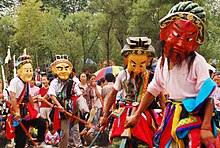Tu (people)
The Tu (own name: Monguor ; Chinese 土族 , Pinyin Tǔzú ) are one of the 55 officially recognized national minorities in the People's Republic of China . They live mainly in the provinces of Qinghai and Gansu .
The livelihoods of the Tu are sheep breeding and, to a lesser extent, the cultivation of grain and vegetables. The Tu are known for their traditional hospitality, although this is slowly disappearing as the old customs are lost.
language
About half of the 289,565 Tu (2010 census) speak Tu 土族 語, also called Mangghuer , which can be divided into two dialects, Huzhu 互助 and Minhe 民和. By contrast, around 5,000 Tu in Tongren speak Bonan保安 語. All others have adopted Chinese or Tibetan as the lingua franca and colloquial language. The Tu language is one of the south-east Mongolian languages and is more closely related to Bonan, Dongxiang and Daur than to Chalcha-Mongolian . The Huzhu dialect is heavily influenced by Tibetan.
The Tu do not have their own script. The Tu language was previously written with the Tibetan script , today the Chinese script is used. Since the 1980s, a modern Tu script based on the Latin alphabet was introduced on an experimental basis.
religion
The Tu are followers of Lamaism ( Tibetan Buddhism ). One of the four great Gelugpa monasteries in the historical Amdo region, Gönlung Champa Ling Monastery (Tibetan dgon lung byams pa gling ; Chinese Youning Si ) is located in what is now Huzhu Autonomous County in the Chinese province of Qinghai.
literature
- Hasbaatar (哈斯 巴特尔Hasibate'er ) u. a. (Ed.): Mônggôr helen u uges / 土族 语 词汇Tuzuyu cihui (vocabulary of the Tu language). 内蒙古 人民出版社Nei Menggu renmin chubanshe (Inner Mongolia People's Publishing House ). 呼和浩特 Hohhot 1985/1986. 18 + 244 pages. [bilingual Mongolian-Chinese, Tu language in IPA].
- Li, Keyu 李克郁: Mongghul qidar merlung / Tu Han cidian土 汉 词典 (Tu Chinese Dictionary). 青海 人民出版社Qinghai renmin chubanshe (Qinghai People's Publishing House ). 西宁 Xining 1988.
- Li, Keyu 李克郁: 土族 (蒙古尔) 源流 考Tuzu (Menggu'er) yuanliu kao (investigations into the origin and development of the Tu nationality / Monguor). 青海 人民出版社Qinghai renmin chubanshe (Qinghai People's Publishing House ). 西宁 Xining 1992/1993. ISBN 7-225-00587-1 . 4 + 6 + 195 pages.
- Mostaert, A. et DeSmedt, A .: Le Dialecte Monguor (The Uralic and Altaic Series; Curzon Press 1997). ISBN 0-7007-0380-2 .
- Qenggeltei (清 格尔泰Qingge'ertai ) u. a. (Ed.): Mônggôr helen u uge helelge yin materiyal / 土族 语 话语 材料Tuzuyu huayu cailiao (language material of the Tu language). 内蒙古 人民出版社Nei Menggu renmin chubanshe (Inner Mongolia People's Publishing House ). 呼和浩特 Hohhot 1986/1988. ISBN 7-204-00438-8 . 17 + 589 pages. [bilingual Mongolian-Chinese, Tu language in IPA]
- Dominik Schröder : On the religion of the Tujen of the Sining area (Kukunor). In: Anthropos, International Journal of Ethnology and Linguistics, Special Edition Volume 47, 1952, Paulusdruckerei, Friborg in Switzerland
- Slater, Keith W .: A grammar of Mangghuer. A Mongolic language of China's Qinghai-Gansu sprachbund. (Asian Linguistics Series; London / New York. Routledge Shorton 2003).
- Stuart, Kevin and Limusishiden (Li, Dechun): China's Monguor Minority. Ethnography and Folktales (Sino-Platonic Papers 59, December 1994).
- Tuzu (Menggu'er) de wenhua xingtai土族 (蒙古尔) 的 文化 形态 (The cultural formation of the Tu [Monguor]). In: Hao, Sumin 郝苏民 u. Wenhua 文化 u. He, Weiguang 贺卫光 (Ed.), 甘 青 特有 民族文化 形态 研究Gan Qing teyou minzu wenhua xingtai yanjiu (research on the cultural formation of the nationalities that only live in Gansu and Qinghai). 民族 出版社Minzu chubanshe (nationality publisher). 北京 Beijing 1999/2000. ISBN 7-105-03420-3 . Pp. 53-101.
- Tuzu jianshi土族 简史 (Brief History of Tu Nationality). 青海 人民出版社Qinghai renmin chubanshe (Qinghai People's Publishing House ). 西宁 Xining 1982.
Web links
- The Tu ethnic minority (Chinese government site in English)
- Tuzu gaishu 土族 概述 (in Chinese)
- Arienne M. Dwyer: Grammatical Sketch of Monguor
- Texts of Monguor (E-MELD School of Best Practice in Digital Language Documentation)
Individual evidence
- ↑ a b c d Klemens Ludwig : Multi-ethnic China: the national minorities in the Middle Kingdom . Beck, Munich 2009, ISBN 978-3-406-59209-6 , pp. 136 .

